Report on Tesco's Business and Environment Factors
VerifiedAdded on 2020/10/22
|17
|4555
|422
Report
AI Summary
This report provides a comprehensive analysis of Tesco's business environment, examining its operations within the UK retail market. The report begins with an introduction to business and the business environment, followed by an overview of Tesco's background. It then explores different types of organizations, including public, private, and voluntary sectors, and discusses the growth of the international business environment. The report delves into detailed descriptions of organizations like NHS, John Lewis Partnership, and Cancer Research UK, highlighting their backgrounds, products and services, size, vision, mission, business objectives, organizational structures, and stakeholder information. Furthermore, the report conducts PESTLE and SWOT analyses of Tesco to identify internal strengths and weaknesses and investigate external and internal environmental factors influencing its business activities. This analysis includes the analysis of sole proprietorship and partnership business models. The report aims to provide a thorough understanding of Tesco's position within the broader business landscape and the factors shaping its success.

UNIT 1 BUSINESS &
BUSINESS ENVIRONMENT
BUSINESS ENVIRONMENT
Paraphrase This Document
Need a fresh take? Get an instant paraphrase of this document with our AI Paraphraser
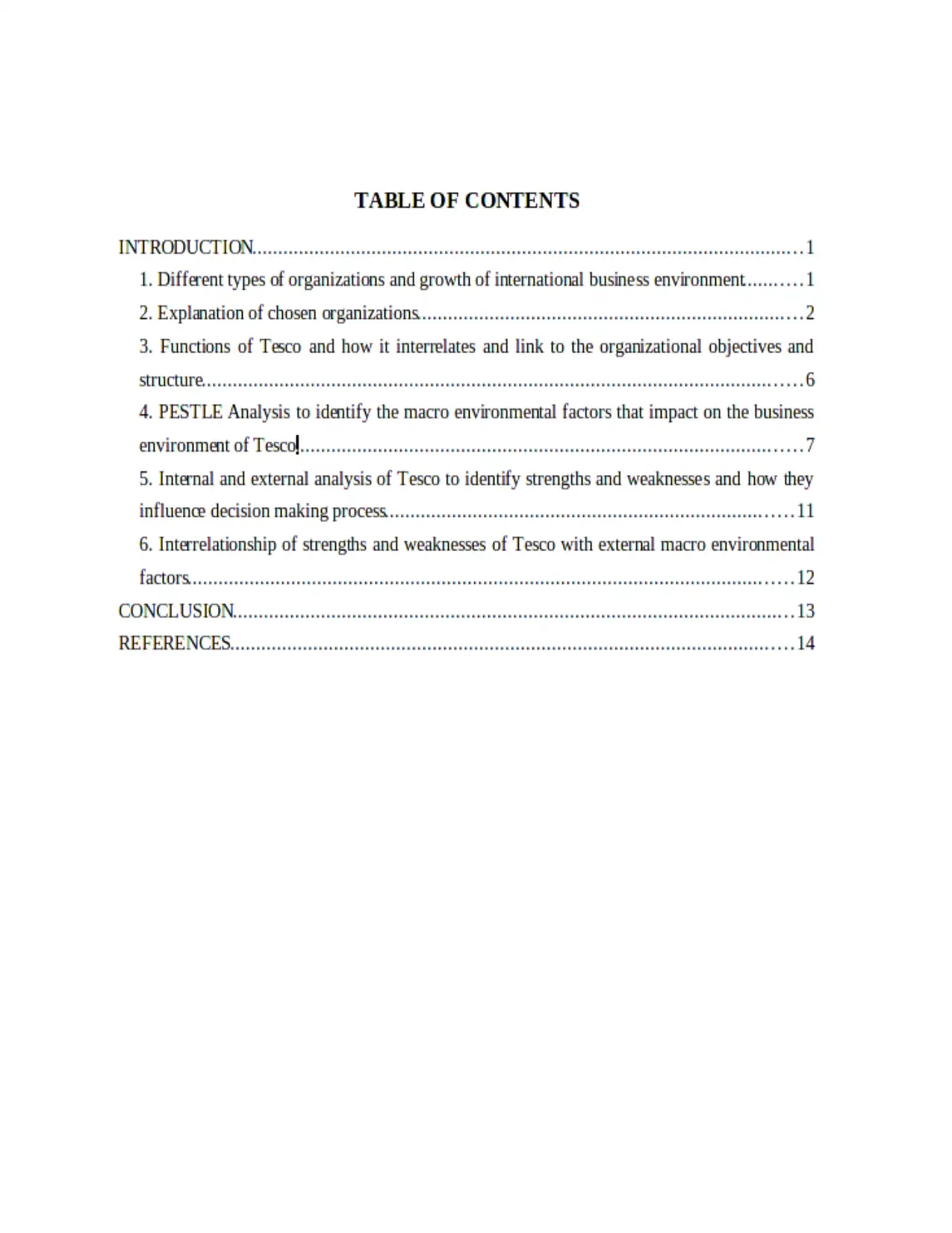
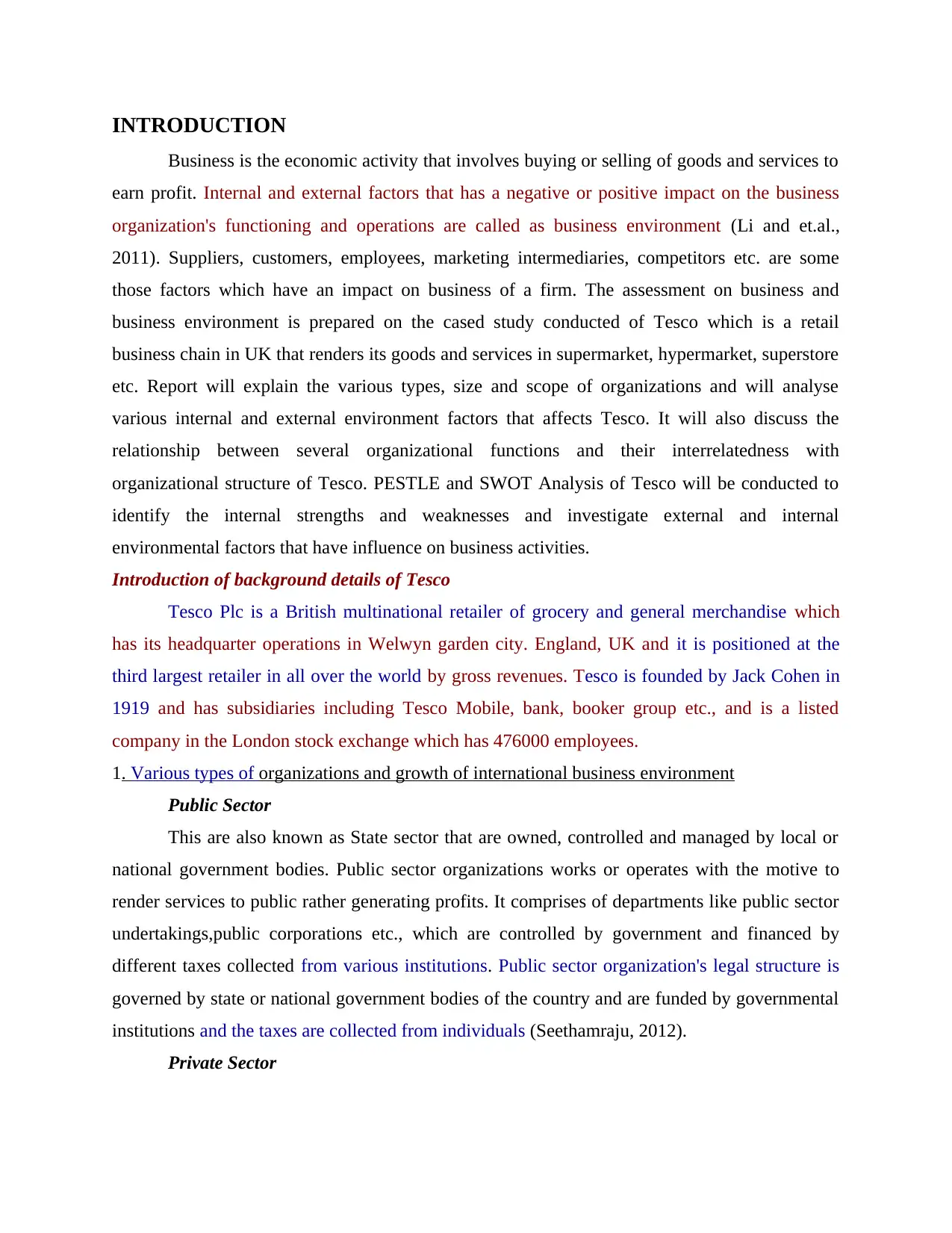
INTRODUCTION
Business is the economic activity that involves buying or selling of goods and services to
earn profit. Internal and external factors that has a negative or positive impact on the business
organization's functioning and operations are called as business environment (Li and et.al.,
2011). Suppliers, customers, employees, marketing intermediaries, competitors etc. are some
those factors which have an impact on business of a firm. The assessment on business and
business environment is prepared on the cased study conducted of Tesco which is a retail
business chain in UK that renders its goods and services in supermarket, hypermarket, superstore
etc. Report will explain the various types, size and scope of organizations and will analyse
various internal and external environment factors that affects Tesco. It will also discuss the
relationship between several organizational functions and their interrelatedness with
organizational structure of Tesco. PESTLE and SWOT Analysis of Tesco will be conducted to
identify the internal strengths and weaknesses and investigate external and internal
environmental factors that have influence on business activities.
Introduction of background details of Tesco
Tesco Plc is a British multinational retailer of grocery and general merchandise which
has its headquarter operations in Welwyn garden city. England, UK and it is positioned at the
third largest retailer in all over the world by gross revenues. Tesco is founded by Jack Cohen in
1919 and has subsidiaries including Tesco Mobile, bank, booker group etc., and is a listed
company in the London stock exchange which has 476000 employees.
1. Various types of organizations and growth of international business environment
Public Sector
This are also known as State sector that are owned, controlled and managed by local or
national government bodies. Public sector organizations works or operates with the motive to
render services to public rather generating profits. It comprises of departments like public sector
undertakings,public corporations etc., which are controlled by government and financed by
different taxes collected from various institutions. Public sector organization's legal structure is
governed by state or national government bodies of the country and are funded by governmental
institutions and the taxes are collected from individuals (Seethamraju, 2012).
Private Sector
Business is the economic activity that involves buying or selling of goods and services to
earn profit. Internal and external factors that has a negative or positive impact on the business
organization's functioning and operations are called as business environment (Li and et.al.,
2011). Suppliers, customers, employees, marketing intermediaries, competitors etc. are some
those factors which have an impact on business of a firm. The assessment on business and
business environment is prepared on the cased study conducted of Tesco which is a retail
business chain in UK that renders its goods and services in supermarket, hypermarket, superstore
etc. Report will explain the various types, size and scope of organizations and will analyse
various internal and external environment factors that affects Tesco. It will also discuss the
relationship between several organizational functions and their interrelatedness with
organizational structure of Tesco. PESTLE and SWOT Analysis of Tesco will be conducted to
identify the internal strengths and weaknesses and investigate external and internal
environmental factors that have influence on business activities.
Introduction of background details of Tesco
Tesco Plc is a British multinational retailer of grocery and general merchandise which
has its headquarter operations in Welwyn garden city. England, UK and it is positioned at the
third largest retailer in all over the world by gross revenues. Tesco is founded by Jack Cohen in
1919 and has subsidiaries including Tesco Mobile, bank, booker group etc., and is a listed
company in the London stock exchange which has 476000 employees.
1. Various types of organizations and growth of international business environment
Public Sector
This are also known as State sector that are owned, controlled and managed by local or
national government bodies. Public sector organizations works or operates with the motive to
render services to public rather generating profits. It comprises of departments like public sector
undertakings,public corporations etc., which are controlled by government and financed by
different taxes collected from various institutions. Public sector organization's legal structure is
governed by state or national government bodies of the country and are funded by governmental
institutions and the taxes are collected from individuals (Seethamraju, 2012).
Private Sector
⊘ This is a preview!⊘
Do you want full access?
Subscribe today to unlock all pages.

Trusted by 1+ million students worldwide
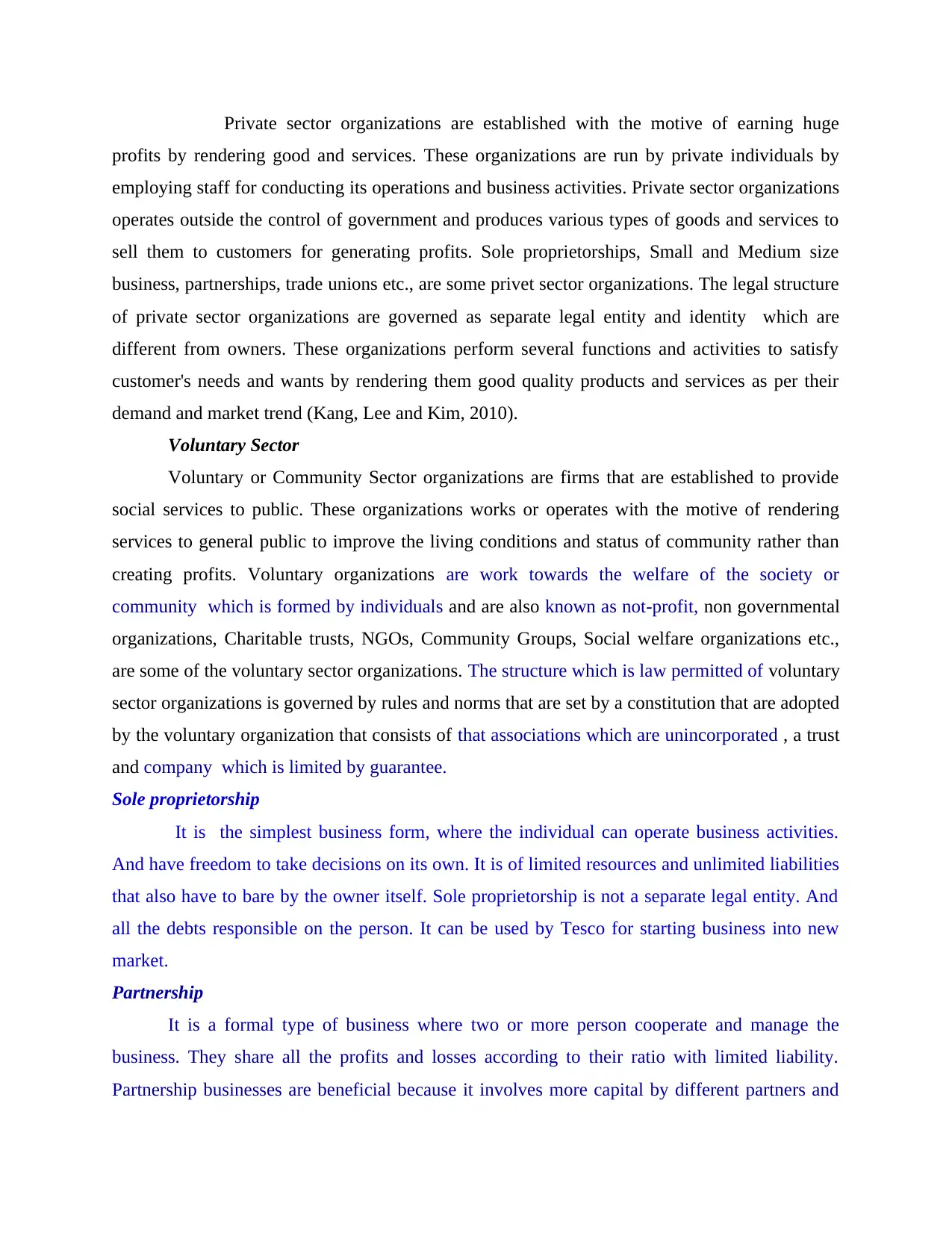
Private sector organizations are established with the motive of earning huge
profits by rendering good and services. These organizations are run by private individuals by
employing staff for conducting its operations and business activities. Private sector organizations
operates outside the control of government and produces various types of goods and services to
sell them to customers for generating profits. Sole proprietorships, Small and Medium size
business, partnerships, trade unions etc., are some privet sector organizations. The legal structure
of private sector organizations are governed as separate legal entity and identity which are
different from owners. These organizations perform several functions and activities to satisfy
customer's needs and wants by rendering them good quality products and services as per their
demand and market trend (Kang, Lee and Kim, 2010).
Voluntary Sector
Voluntary or Community Sector organizations are firms that are established to provide
social services to public. These organizations works or operates with the motive of rendering
services to general public to improve the living conditions and status of community rather than
creating profits. Voluntary organizations are work towards the welfare of the society or
community which is formed by individuals and are also known as not-profit, non governmental
organizations, Charitable trusts, NGOs, Community Groups, Social welfare organizations etc.,
are some of the voluntary sector organizations. The structure which is law permitted of voluntary
sector organizations is governed by rules and norms that are set by a constitution that are adopted
by the voluntary organization that consists of that associations which are unincorporated , a trust
and company which is limited by guarantee.
Sole proprietorship
It is the simplest business form, where the individual can operate business activities.
And have freedom to take decisions on its own. It is of limited resources and unlimited liabilities
that also have to bare by the owner itself. Sole proprietorship is not a separate legal entity. And
all the debts responsible on the person. It can be used by Tesco for starting business into new
market.
Partnership
It is a formal type of business where two or more person cooperate and manage the
business. They share all the profits and losses according to their ratio with limited liability.
Partnership businesses are beneficial because it involves more capital by different partners and
profits by rendering good and services. These organizations are run by private individuals by
employing staff for conducting its operations and business activities. Private sector organizations
operates outside the control of government and produces various types of goods and services to
sell them to customers for generating profits. Sole proprietorships, Small and Medium size
business, partnerships, trade unions etc., are some privet sector organizations. The legal structure
of private sector organizations are governed as separate legal entity and identity which are
different from owners. These organizations perform several functions and activities to satisfy
customer's needs and wants by rendering them good quality products and services as per their
demand and market trend (Kang, Lee and Kim, 2010).
Voluntary Sector
Voluntary or Community Sector organizations are firms that are established to provide
social services to public. These organizations works or operates with the motive of rendering
services to general public to improve the living conditions and status of community rather than
creating profits. Voluntary organizations are work towards the welfare of the society or
community which is formed by individuals and are also known as not-profit, non governmental
organizations, Charitable trusts, NGOs, Community Groups, Social welfare organizations etc.,
are some of the voluntary sector organizations. The structure which is law permitted of voluntary
sector organizations is governed by rules and norms that are set by a constitution that are adopted
by the voluntary organization that consists of that associations which are unincorporated , a trust
and company which is limited by guarantee.
Sole proprietorship
It is the simplest business form, where the individual can operate business activities.
And have freedom to take decisions on its own. It is of limited resources and unlimited liabilities
that also have to bare by the owner itself. Sole proprietorship is not a separate legal entity. And
all the debts responsible on the person. It can be used by Tesco for starting business into new
market.
Partnership
It is a formal type of business where two or more person cooperate and manage the
business. They share all the profits and losses according to their ratio with limited liability.
Partnership businesses are beneficial because it involves more capital by different partners and
Paraphrase This Document
Need a fresh take? Get an instant paraphrase of this document with our AI Paraphraser
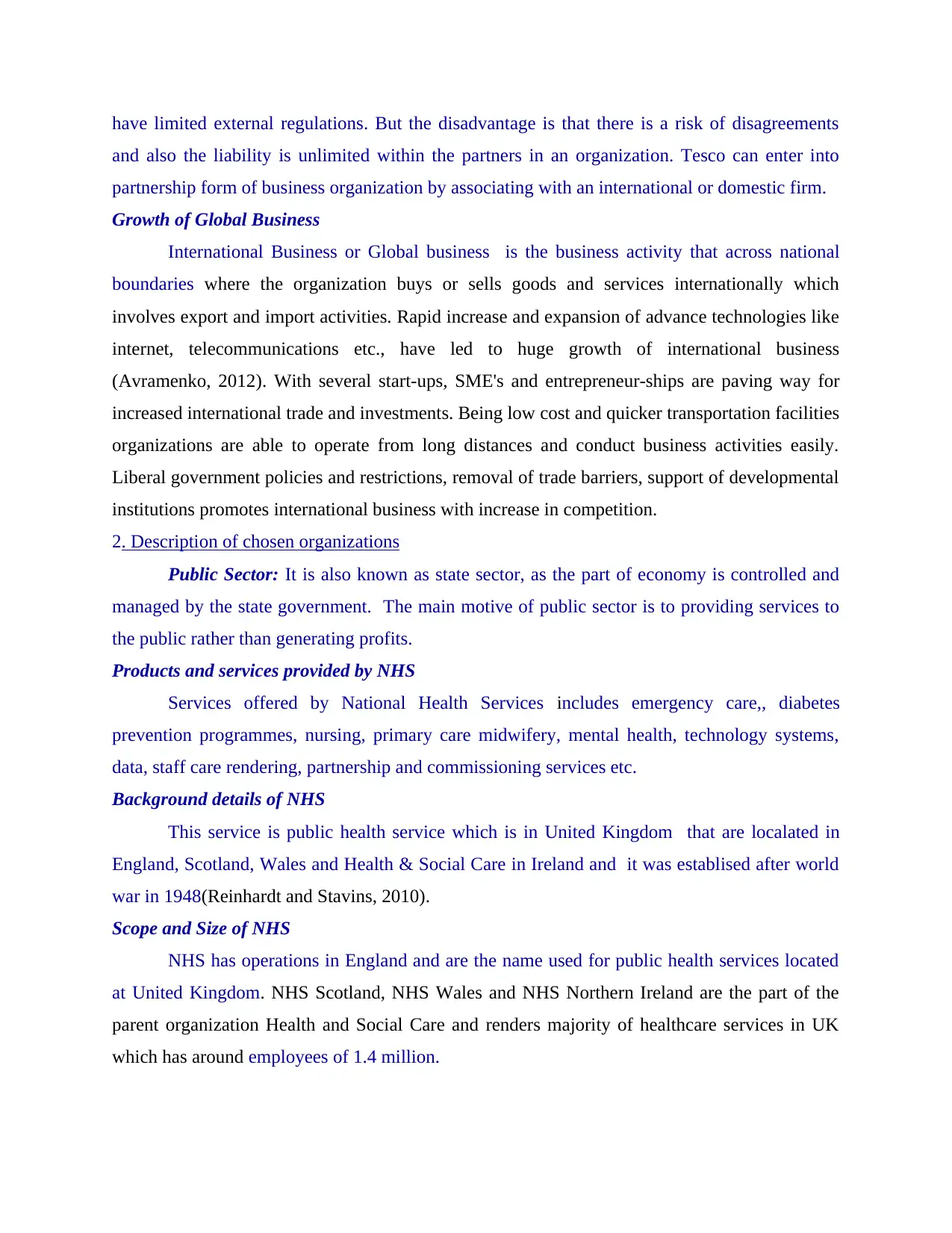
have limited external regulations. But the disadvantage is that there is a risk of disagreements
and also the liability is unlimited within the partners in an organization. Tesco can enter into
partnership form of business organization by associating with an international or domestic firm.
Growth of Global Business
International Business or Global business is the business activity that across national
boundaries where the organization buys or sells goods and services internationally which
involves export and import activities. Rapid increase and expansion of advance technologies like
internet, telecommunications etc., have led to huge growth of international business
(Avramenko, 2012). With several start-ups, SME's and entrepreneur-ships are paving way for
increased international trade and investments. Being low cost and quicker transportation facilities
organizations are able to operate from long distances and conduct business activities easily.
Liberal government policies and restrictions, removal of trade barriers, support of developmental
institutions promotes international business with increase in competition.
2. Description of chosen organizations
Public Sector: It is also known as state sector, as the part of economy is controlled and
managed by the state government. The main motive of public sector is to providing services to
the public rather than generating profits.
Products and services provided by NHS
Services offered by National Health Services includes emergency care,, diabetes
prevention programmes, nursing, primary care midwifery, mental health, technology systems,
data, staff care rendering, partnership and commissioning services etc.
Background details of NHS
This service is public health service which is in United Kingdom that are localated in
England, Scotland, Wales and Health & Social Care in Ireland and it was establised after world
war in 1948(Reinhardt and Stavins, 2010).
Scope and Size of NHS
NHS has operations in England and are the name used for public health services located
at United Kingdom. NHS Scotland, NHS Wales and NHS Northern Ireland are the part of the
parent organization Health and Social Care and renders majority of healthcare services in UK
which has around employees of 1.4 million.
and also the liability is unlimited within the partners in an organization. Tesco can enter into
partnership form of business organization by associating with an international or domestic firm.
Growth of Global Business
International Business or Global business is the business activity that across national
boundaries where the organization buys or sells goods and services internationally which
involves export and import activities. Rapid increase and expansion of advance technologies like
internet, telecommunications etc., have led to huge growth of international business
(Avramenko, 2012). With several start-ups, SME's and entrepreneur-ships are paving way for
increased international trade and investments. Being low cost and quicker transportation facilities
organizations are able to operate from long distances and conduct business activities easily.
Liberal government policies and restrictions, removal of trade barriers, support of developmental
institutions promotes international business with increase in competition.
2. Description of chosen organizations
Public Sector: It is also known as state sector, as the part of economy is controlled and
managed by the state government. The main motive of public sector is to providing services to
the public rather than generating profits.
Products and services provided by NHS
Services offered by National Health Services includes emergency care,, diabetes
prevention programmes, nursing, primary care midwifery, mental health, technology systems,
data, staff care rendering, partnership and commissioning services etc.
Background details of NHS
This service is public health service which is in United Kingdom that are localated in
England, Scotland, Wales and Health & Social Care in Ireland and it was establised after world
war in 1948(Reinhardt and Stavins, 2010).
Scope and Size of NHS
NHS has operations in England and are the name used for public health services located
at United Kingdom. NHS Scotland, NHS Wales and NHS Northern Ireland are the part of the
parent organization Health and Social Care and renders majority of healthcare services in UK
which has around employees of 1.4 million.
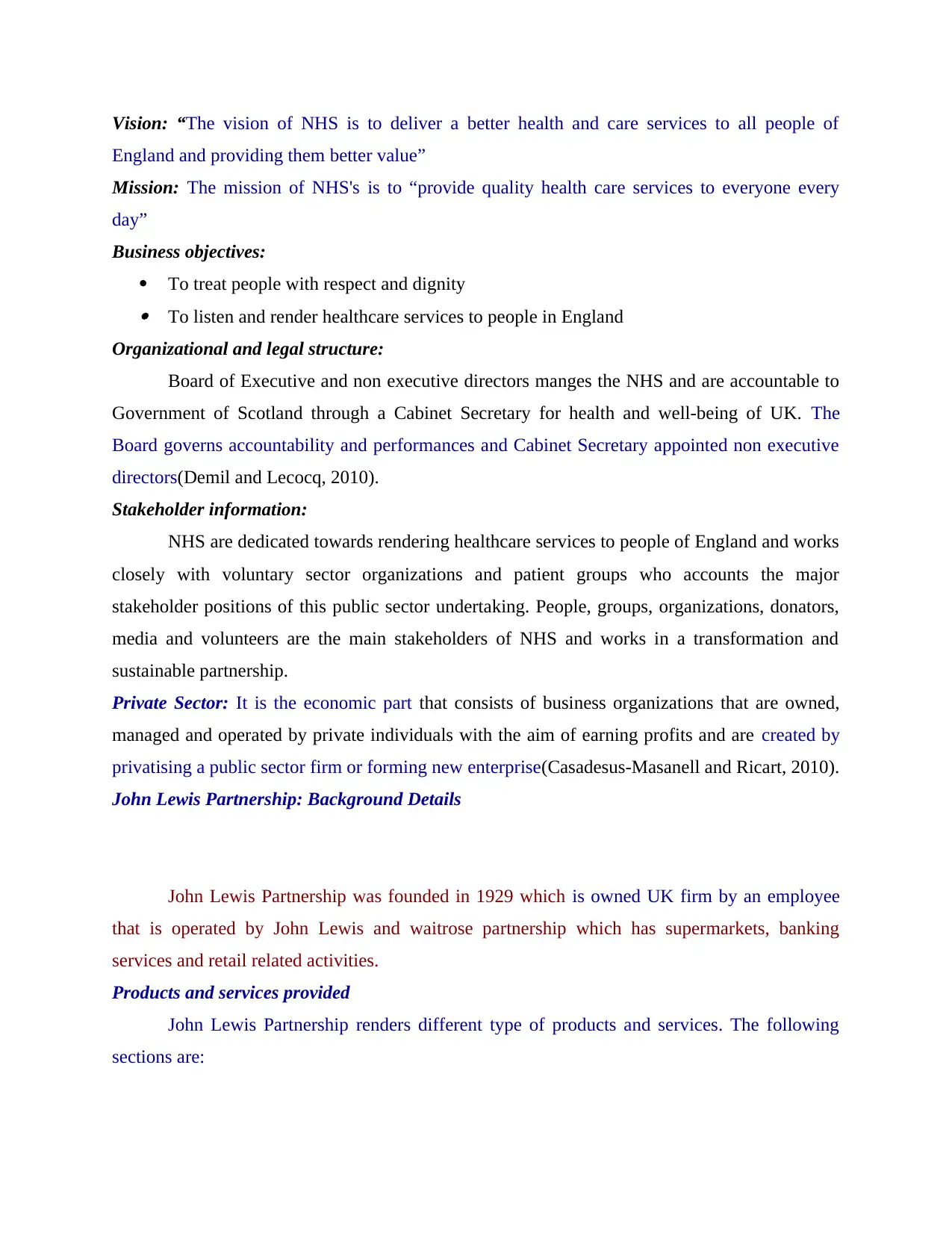
Vision: “The vision of NHS is to deliver a better health and care services to all people of
England and providing them better value”
Mission: The mission of NHS's is to “provide quality health care services to everyone every
day”
Business objectives:
To treat people with respect and dignity To listen and render healthcare services to people in England
Organizational and legal structure:
Board of Executive and non executive directors manges the NHS and are accountable to
Government of Scotland through a Cabinet Secretary for health and well-being of UK. The
Board governs accountability and performances and Cabinet Secretary appointed non executive
directors(Demil and Lecocq, 2010).
Stakeholder information:
NHS are dedicated towards rendering healthcare services to people of England and works
closely with voluntary sector organizations and patient groups who accounts the major
stakeholder positions of this public sector undertaking. People, groups, organizations, donators,
media and volunteers are the main stakeholders of NHS and works in a transformation and
sustainable partnership.
Private Sector: It is the economic part that consists of business organizations that are owned,
managed and operated by private individuals with the aim of earning profits and are created by
privatising a public sector firm or forming new enterprise(Casadesus-Masanell and Ricart, 2010).
John Lewis Partnership: Background Details
John Lewis Partnership was founded in 1929 which is owned UK firm by an employee
that is operated by John Lewis and waitrose partnership which has supermarkets, banking
services and retail related activities.
Products and services provided
John Lewis Partnership renders different type of products and services. The following
sections are:
England and providing them better value”
Mission: The mission of NHS's is to “provide quality health care services to everyone every
day”
Business objectives:
To treat people with respect and dignity To listen and render healthcare services to people in England
Organizational and legal structure:
Board of Executive and non executive directors manges the NHS and are accountable to
Government of Scotland through a Cabinet Secretary for health and well-being of UK. The
Board governs accountability and performances and Cabinet Secretary appointed non executive
directors(Demil and Lecocq, 2010).
Stakeholder information:
NHS are dedicated towards rendering healthcare services to people of England and works
closely with voluntary sector organizations and patient groups who accounts the major
stakeholder positions of this public sector undertaking. People, groups, organizations, donators,
media and volunteers are the main stakeholders of NHS and works in a transformation and
sustainable partnership.
Private Sector: It is the economic part that consists of business organizations that are owned,
managed and operated by private individuals with the aim of earning profits and are created by
privatising a public sector firm or forming new enterprise(Casadesus-Masanell and Ricart, 2010).
John Lewis Partnership: Background Details
John Lewis Partnership was founded in 1929 which is owned UK firm by an employee
that is operated by John Lewis and waitrose partnership which has supermarkets, banking
services and retail related activities.
Products and services provided
John Lewis Partnership renders different type of products and services. The following
sections are:
⊘ This is a preview!⊘
Do you want full access?
Subscribe today to unlock all pages.

Trusted by 1+ million students worldwide
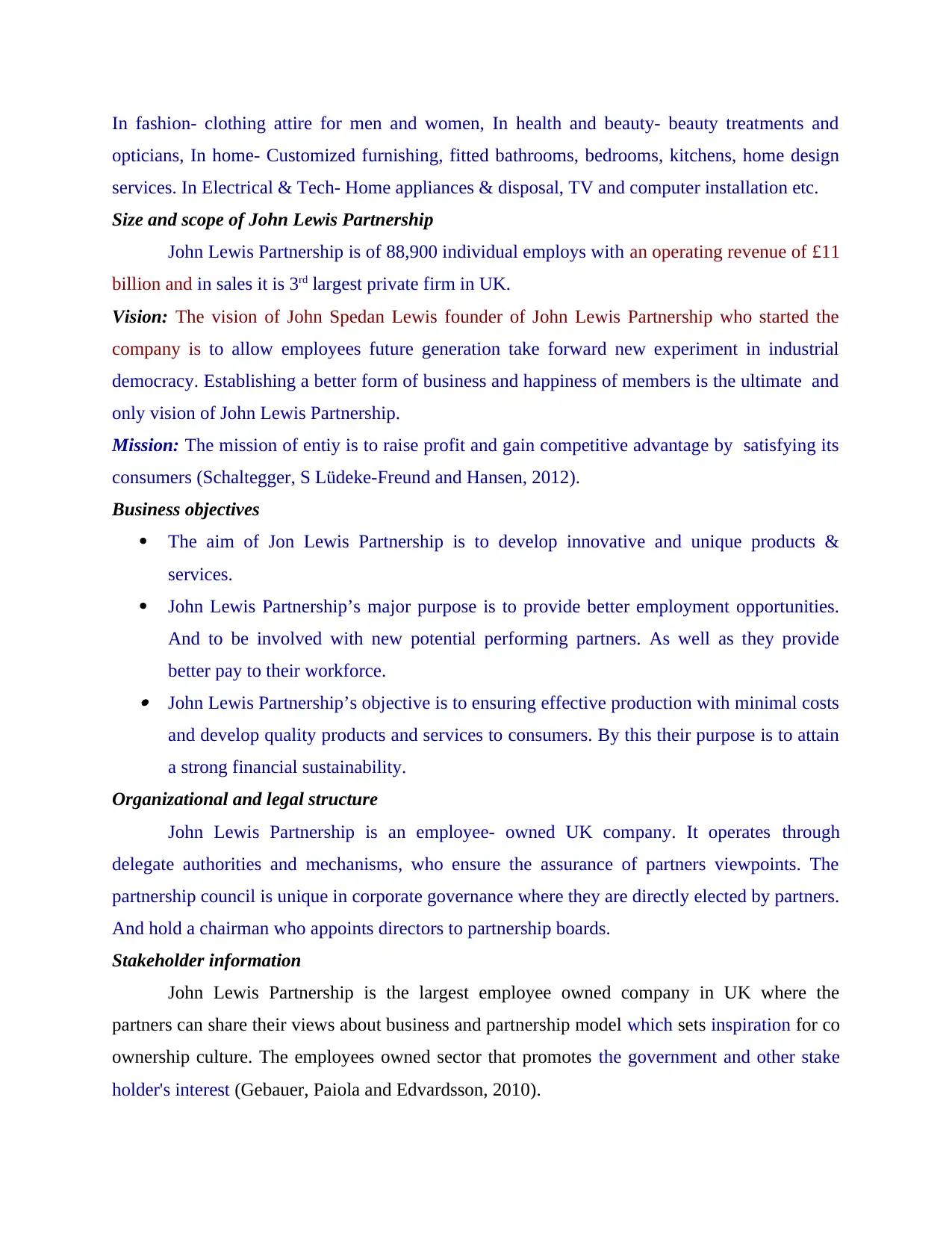
In fashion- clothing attire for men and women, In health and beauty- beauty treatments and
opticians, In home- Customized furnishing, fitted bathrooms, bedrooms, kitchens, home design
services. In Electrical & Tech- Home appliances & disposal, TV and computer installation etc.
Size and scope of John Lewis Partnership
John Lewis Partnership is of 88,900 individual employs with an operating revenue of £11
billion and in sales it is 3rd largest private firm in UK.
Vision: The vision of John Spedan Lewis founder of John Lewis Partnership who started the
company is to allow employees future generation take forward new experiment in industrial
democracy. Establishing a better form of business and happiness of members is the ultimate and
only vision of John Lewis Partnership.
Mission: The mission of entiy is to raise profit and gain competitive advantage by satisfying its
consumers (Schaltegger, S Lüdeke-Freund and Hansen, 2012).
Business objectives
The aim of Jon Lewis Partnership is to develop innovative and unique products &
services.
John Lewis Partnership’s major purpose is to provide better employment opportunities.
And to be involved with new potential performing partners. As well as they provide
better pay to their workforce. John Lewis Partnership’s objective is to ensuring effective production with minimal costs
and develop quality products and services to consumers. By this their purpose is to attain
a strong financial sustainability.
Organizational and legal structure
John Lewis Partnership is an employee- owned UK company. It operates through
delegate authorities and mechanisms, who ensure the assurance of partners viewpoints. The
partnership council is unique in corporate governance where they are directly elected by partners.
And hold a chairman who appoints directors to partnership boards.
Stakeholder information
John Lewis Partnership is the largest employee owned company in UK where the
partners can share their views about business and partnership model which sets inspiration for co
ownership culture. The employees owned sector that promotes the government and other stake
holder's interest (Gebauer, Paiola and Edvardsson, 2010).
opticians, In home- Customized furnishing, fitted bathrooms, bedrooms, kitchens, home design
services. In Electrical & Tech- Home appliances & disposal, TV and computer installation etc.
Size and scope of John Lewis Partnership
John Lewis Partnership is of 88,900 individual employs with an operating revenue of £11
billion and in sales it is 3rd largest private firm in UK.
Vision: The vision of John Spedan Lewis founder of John Lewis Partnership who started the
company is to allow employees future generation take forward new experiment in industrial
democracy. Establishing a better form of business and happiness of members is the ultimate and
only vision of John Lewis Partnership.
Mission: The mission of entiy is to raise profit and gain competitive advantage by satisfying its
consumers (Schaltegger, S Lüdeke-Freund and Hansen, 2012).
Business objectives
The aim of Jon Lewis Partnership is to develop innovative and unique products &
services.
John Lewis Partnership’s major purpose is to provide better employment opportunities.
And to be involved with new potential performing partners. As well as they provide
better pay to their workforce. John Lewis Partnership’s objective is to ensuring effective production with minimal costs
and develop quality products and services to consumers. By this their purpose is to attain
a strong financial sustainability.
Organizational and legal structure
John Lewis Partnership is an employee- owned UK company. It operates through
delegate authorities and mechanisms, who ensure the assurance of partners viewpoints. The
partnership council is unique in corporate governance where they are directly elected by partners.
And hold a chairman who appoints directors to partnership boards.
Stakeholder information
John Lewis Partnership is the largest employee owned company in UK where the
partners can share their views about business and partnership model which sets inspiration for co
ownership culture. The employees owned sector that promotes the government and other stake
holder's interest (Gebauer, Paiola and Edvardsson, 2010).
Paraphrase This Document
Need a fresh take? Get an instant paraphrase of this document with our AI Paraphraser
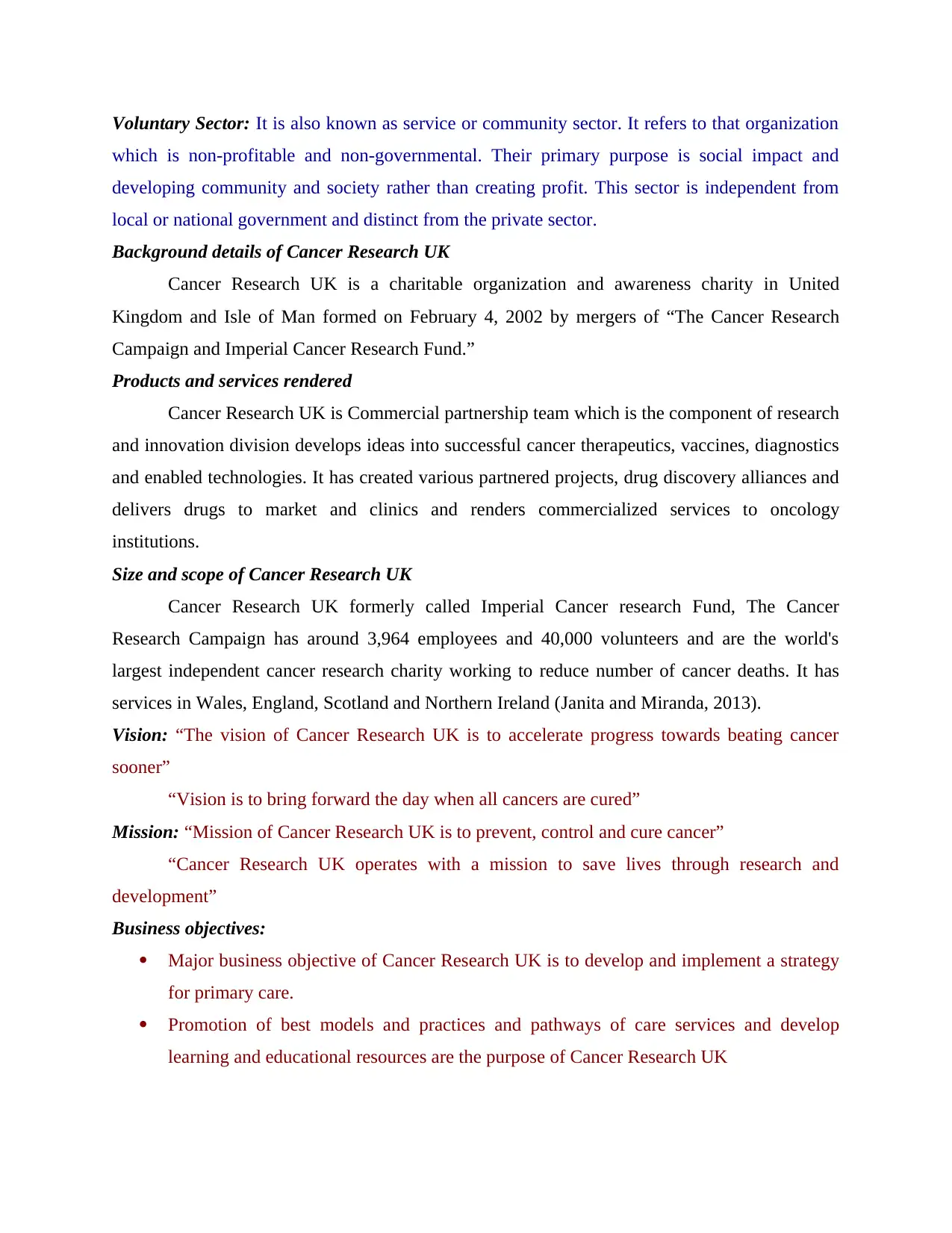
Voluntary Sector: It is also known as service or community sector. It refers to that organization
which is non-profitable and non-governmental. Their primary purpose is social impact and
developing community and society rather than creating profit. This sector is independent from
local or national government and distinct from the private sector.
Background details of Cancer Research UK
Cancer Research UK is a charitable organization and awareness charity in United
Kingdom and Isle of Man formed on February 4, 2002 by mergers of “The Cancer Research
Campaign and Imperial Cancer Research Fund.”
Products and services rendered
Cancer Research UK is Commercial partnership team which is the component of research
and innovation division develops ideas into successful cancer therapeutics, vaccines, diagnostics
and enabled technologies. It has created various partnered projects, drug discovery alliances and
delivers drugs to market and clinics and renders commercialized services to oncology
institutions.
Size and scope of Cancer Research UK
Cancer Research UK formerly called Imperial Cancer research Fund, The Cancer
Research Campaign has around 3,964 employees and 40,000 volunteers and are the world's
largest independent cancer research charity working to reduce number of cancer deaths. It has
services in Wales, England, Scotland and Northern Ireland (Janita and Miranda, 2013).
Vision: “The vision of Cancer Research UK is to accelerate progress towards beating cancer
sooner”
“Vision is to bring forward the day when all cancers are cured”
Mission: “Mission of Cancer Research UK is to prevent, control and cure cancer”
“Cancer Research UK operates with a mission to save lives through research and
development”
Business objectives:
Major business objective of Cancer Research UK is to develop and implement a strategy
for primary care.
Promotion of best models and practices and pathways of care services and develop
learning and educational resources are the purpose of Cancer Research UK
which is non-profitable and non-governmental. Their primary purpose is social impact and
developing community and society rather than creating profit. This sector is independent from
local or national government and distinct from the private sector.
Background details of Cancer Research UK
Cancer Research UK is a charitable organization and awareness charity in United
Kingdom and Isle of Man formed on February 4, 2002 by mergers of “The Cancer Research
Campaign and Imperial Cancer Research Fund.”
Products and services rendered
Cancer Research UK is Commercial partnership team which is the component of research
and innovation division develops ideas into successful cancer therapeutics, vaccines, diagnostics
and enabled technologies. It has created various partnered projects, drug discovery alliances and
delivers drugs to market and clinics and renders commercialized services to oncology
institutions.
Size and scope of Cancer Research UK
Cancer Research UK formerly called Imperial Cancer research Fund, The Cancer
Research Campaign has around 3,964 employees and 40,000 volunteers and are the world's
largest independent cancer research charity working to reduce number of cancer deaths. It has
services in Wales, England, Scotland and Northern Ireland (Janita and Miranda, 2013).
Vision: “The vision of Cancer Research UK is to accelerate progress towards beating cancer
sooner”
“Vision is to bring forward the day when all cancers are cured”
Mission: “Mission of Cancer Research UK is to prevent, control and cure cancer”
“Cancer Research UK operates with a mission to save lives through research and
development”
Business objectives:
Major business objective of Cancer Research UK is to develop and implement a strategy
for primary care.
Promotion of best models and practices and pathways of care services and develop
learning and educational resources are the purpose of Cancer Research UK
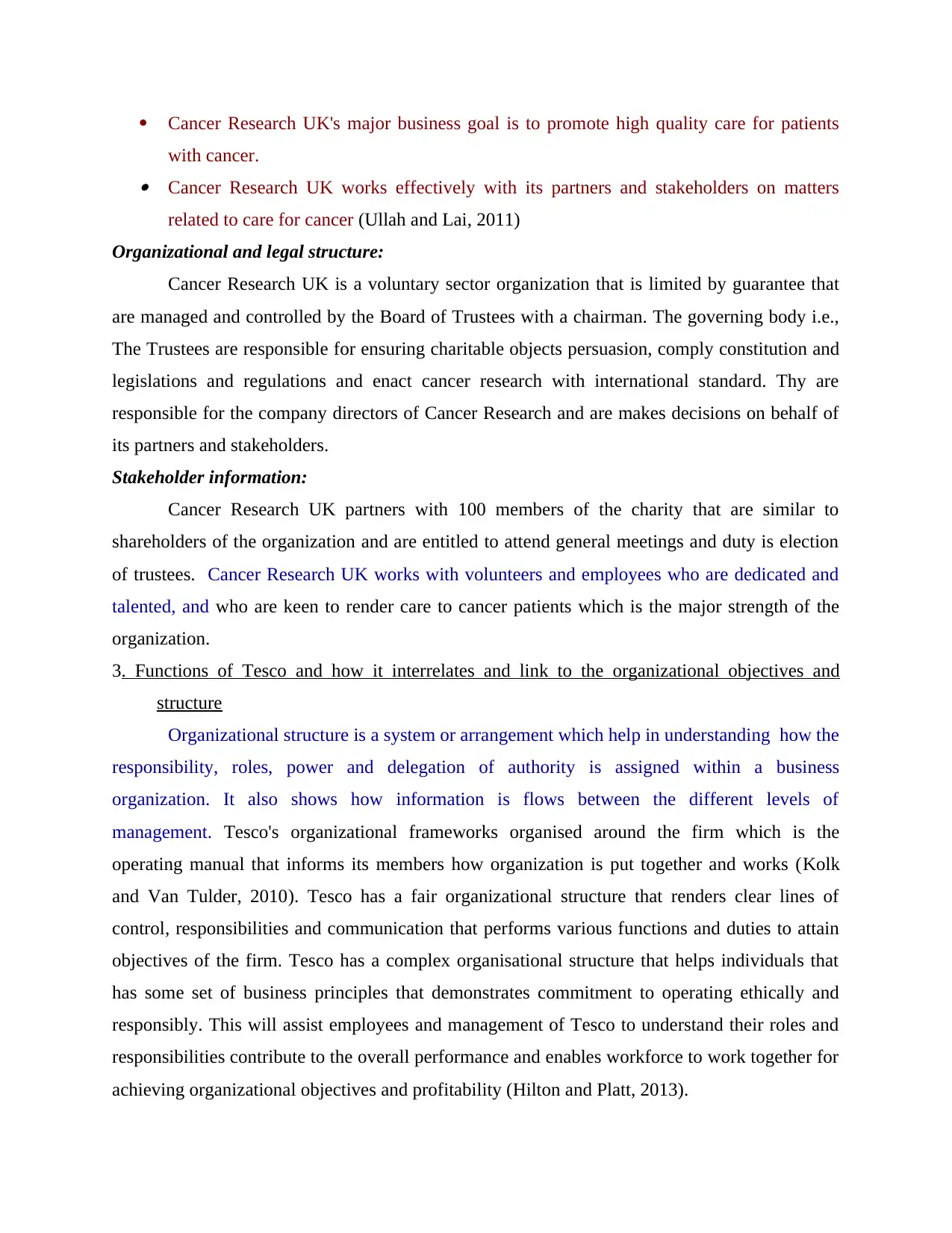
Cancer Research UK's major business goal is to promote high quality care for patients
with cancer. Cancer Research UK works effectively with its partners and stakeholders on matters
related to care for cancer (Ullah and Lai, 2011)
Organizational and legal structure:
Cancer Research UK is a voluntary sector organization that is limited by guarantee that
are managed and controlled by the Board of Trustees with a chairman. The governing body i.e.,
The Trustees are responsible for ensuring charitable objects persuasion, comply constitution and
legislations and regulations and enact cancer research with international standard. Thy are
responsible for the company directors of Cancer Research and are makes decisions on behalf of
its partners and stakeholders.
Stakeholder information:
Cancer Research UK partners with 100 members of the charity that are similar to
shareholders of the organization and are entitled to attend general meetings and duty is election
of trustees. Cancer Research UK works with volunteers and employees who are dedicated and
talented, and who are keen to render care to cancer patients which is the major strength of the
organization.
3. Functions of Tesco and how it interrelates and link to the organizational objectives and
structure
Organizational structure is a system or arrangement which help in understanding how the
responsibility, roles, power and delegation of authority is assigned within a business
organization. It also shows how information is flows between the different levels of
management. Tesco's organizational frameworks organised around the firm which is the
operating manual that informs its members how organization is put together and works (Kolk
and Van Tulder, 2010). Tesco has a fair organizational structure that renders clear lines of
control, responsibilities and communication that performs various functions and duties to attain
objectives of the firm. Tesco has a complex organisational structure that helps individuals that
has some set of business principles that demonstrates commitment to operating ethically and
responsibly. This will assist employees and management of Tesco to understand their roles and
responsibilities contribute to the overall performance and enables workforce to work together for
achieving organizational objectives and profitability (Hilton and Platt, 2013).
with cancer. Cancer Research UK works effectively with its partners and stakeholders on matters
related to care for cancer (Ullah and Lai, 2011)
Organizational and legal structure:
Cancer Research UK is a voluntary sector organization that is limited by guarantee that
are managed and controlled by the Board of Trustees with a chairman. The governing body i.e.,
The Trustees are responsible for ensuring charitable objects persuasion, comply constitution and
legislations and regulations and enact cancer research with international standard. Thy are
responsible for the company directors of Cancer Research and are makes decisions on behalf of
its partners and stakeholders.
Stakeholder information:
Cancer Research UK partners with 100 members of the charity that are similar to
shareholders of the organization and are entitled to attend general meetings and duty is election
of trustees. Cancer Research UK works with volunteers and employees who are dedicated and
talented, and who are keen to render care to cancer patients which is the major strength of the
organization.
3. Functions of Tesco and how it interrelates and link to the organizational objectives and
structure
Organizational structure is a system or arrangement which help in understanding how the
responsibility, roles, power and delegation of authority is assigned within a business
organization. It also shows how information is flows between the different levels of
management. Tesco's organizational frameworks organised around the firm which is the
operating manual that informs its members how organization is put together and works (Kolk
and Van Tulder, 2010). Tesco has a fair organizational structure that renders clear lines of
control, responsibilities and communication that performs various functions and duties to attain
objectives of the firm. Tesco has a complex organisational structure that helps individuals that
has some set of business principles that demonstrates commitment to operating ethically and
responsibly. This will assist employees and management of Tesco to understand their roles and
responsibilities contribute to the overall performance and enables workforce to work together for
achieving organizational objectives and profitability (Hilton and Platt, 2013).
⊘ This is a preview!⊘
Do you want full access?
Subscribe today to unlock all pages.

Trusted by 1+ million students worldwide
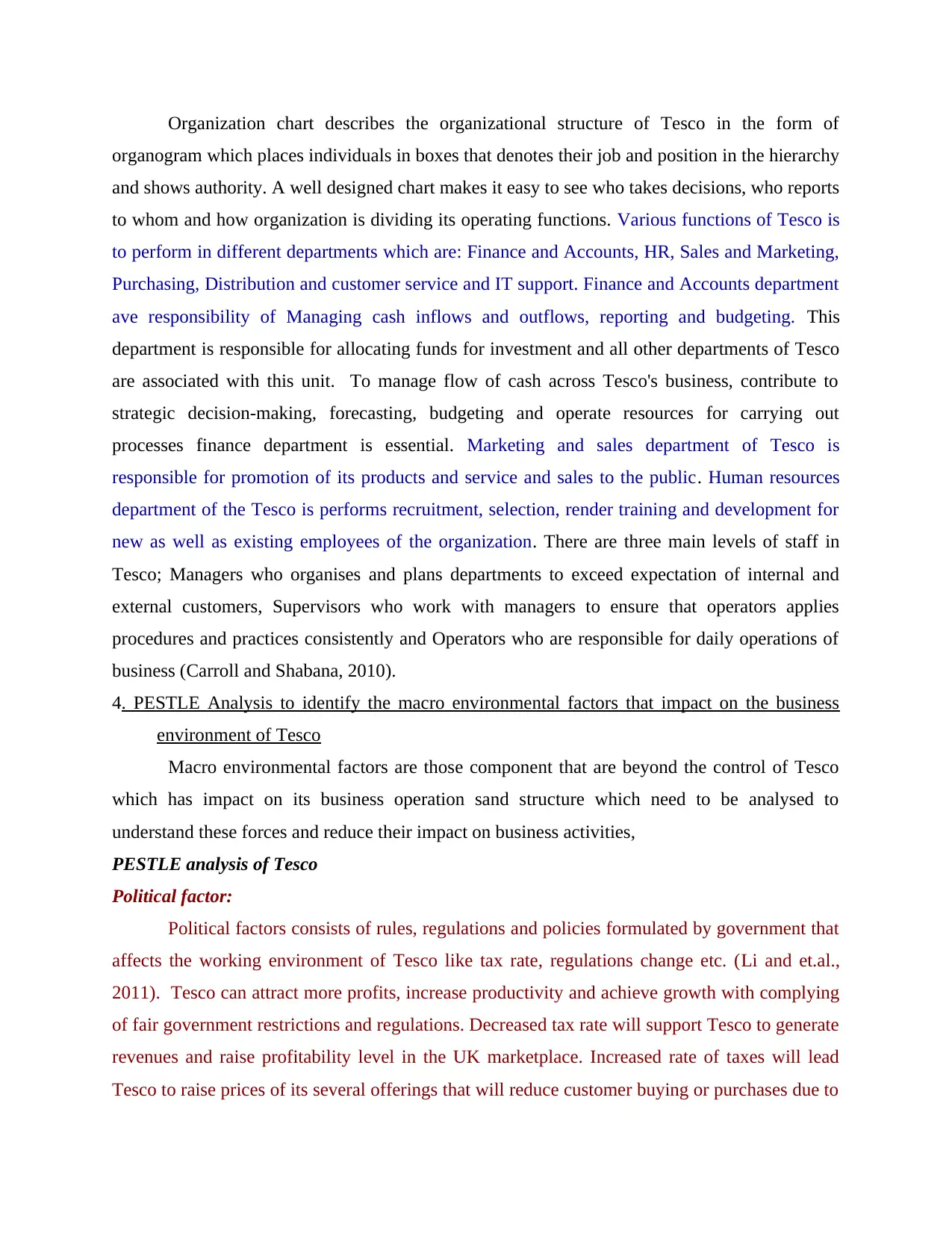
Organization chart describes the organizational structure of Tesco in the form of
organogram which places individuals in boxes that denotes their job and position in the hierarchy
and shows authority. A well designed chart makes it easy to see who takes decisions, who reports
to whom and how organization is dividing its operating functions. Various functions of Tesco is
to perform in different departments which are: Finance and Accounts, HR, Sales and Marketing,
Purchasing, Distribution and customer service and IT support. Finance and Accounts department
ave responsibility of Managing cash inflows and outflows, reporting and budgeting. This
department is responsible for allocating funds for investment and all other departments of Tesco
are associated with this unit. To manage flow of cash across Tesco's business, contribute to
strategic decision-making, forecasting, budgeting and operate resources for carrying out
processes finance department is essential. Marketing and sales department of Tesco is
responsible for promotion of its products and service and sales to the public. Human resources
department of the Tesco is performs recruitment, selection, render training and development for
new as well as existing employees of the organization. There are three main levels of staff in
Tesco; Managers who organises and plans departments to exceed expectation of internal and
external customers, Supervisors who work with managers to ensure that operators applies
procedures and practices consistently and Operators who are responsible for daily operations of
business (Carroll and Shabana, 2010).
4. PESTLE Analysis to identify the macro environmental factors that impact on the business
environment of Tesco
Macro environmental factors are those component that are beyond the control of Tesco
which has impact on its business operation sand structure which need to be analysed to
understand these forces and reduce their impact on business activities,
PESTLE analysis of Tesco
Political factor:
Political factors consists of rules, regulations and policies formulated by government that
affects the working environment of Tesco like tax rate, regulations change etc. (Li and et.al.,
2011). Tesco can attract more profits, increase productivity and achieve growth with complying
of fair government restrictions and regulations. Decreased tax rate will support Tesco to generate
revenues and raise profitability level in the UK marketplace. Increased rate of taxes will lead
Tesco to raise prices of its several offerings that will reduce customer buying or purchases due to
organogram which places individuals in boxes that denotes their job and position in the hierarchy
and shows authority. A well designed chart makes it easy to see who takes decisions, who reports
to whom and how organization is dividing its operating functions. Various functions of Tesco is
to perform in different departments which are: Finance and Accounts, HR, Sales and Marketing,
Purchasing, Distribution and customer service and IT support. Finance and Accounts department
ave responsibility of Managing cash inflows and outflows, reporting and budgeting. This
department is responsible for allocating funds for investment and all other departments of Tesco
are associated with this unit. To manage flow of cash across Tesco's business, contribute to
strategic decision-making, forecasting, budgeting and operate resources for carrying out
processes finance department is essential. Marketing and sales department of Tesco is
responsible for promotion of its products and service and sales to the public. Human resources
department of the Tesco is performs recruitment, selection, render training and development for
new as well as existing employees of the organization. There are three main levels of staff in
Tesco; Managers who organises and plans departments to exceed expectation of internal and
external customers, Supervisors who work with managers to ensure that operators applies
procedures and practices consistently and Operators who are responsible for daily operations of
business (Carroll and Shabana, 2010).
4. PESTLE Analysis to identify the macro environmental factors that impact on the business
environment of Tesco
Macro environmental factors are those component that are beyond the control of Tesco
which has impact on its business operation sand structure which need to be analysed to
understand these forces and reduce their impact on business activities,
PESTLE analysis of Tesco
Political factor:
Political factors consists of rules, regulations and policies formulated by government that
affects the working environment of Tesco like tax rate, regulations change etc. (Li and et.al.,
2011). Tesco can attract more profits, increase productivity and achieve growth with complying
of fair government restrictions and regulations. Decreased tax rate will support Tesco to generate
revenues and raise profitability level in the UK marketplace. Increased rate of taxes will lead
Tesco to raise prices of its several offerings that will reduce customer buying or purchases due to
Paraphrase This Document
Need a fresh take? Get an instant paraphrase of this document with our AI Paraphraser
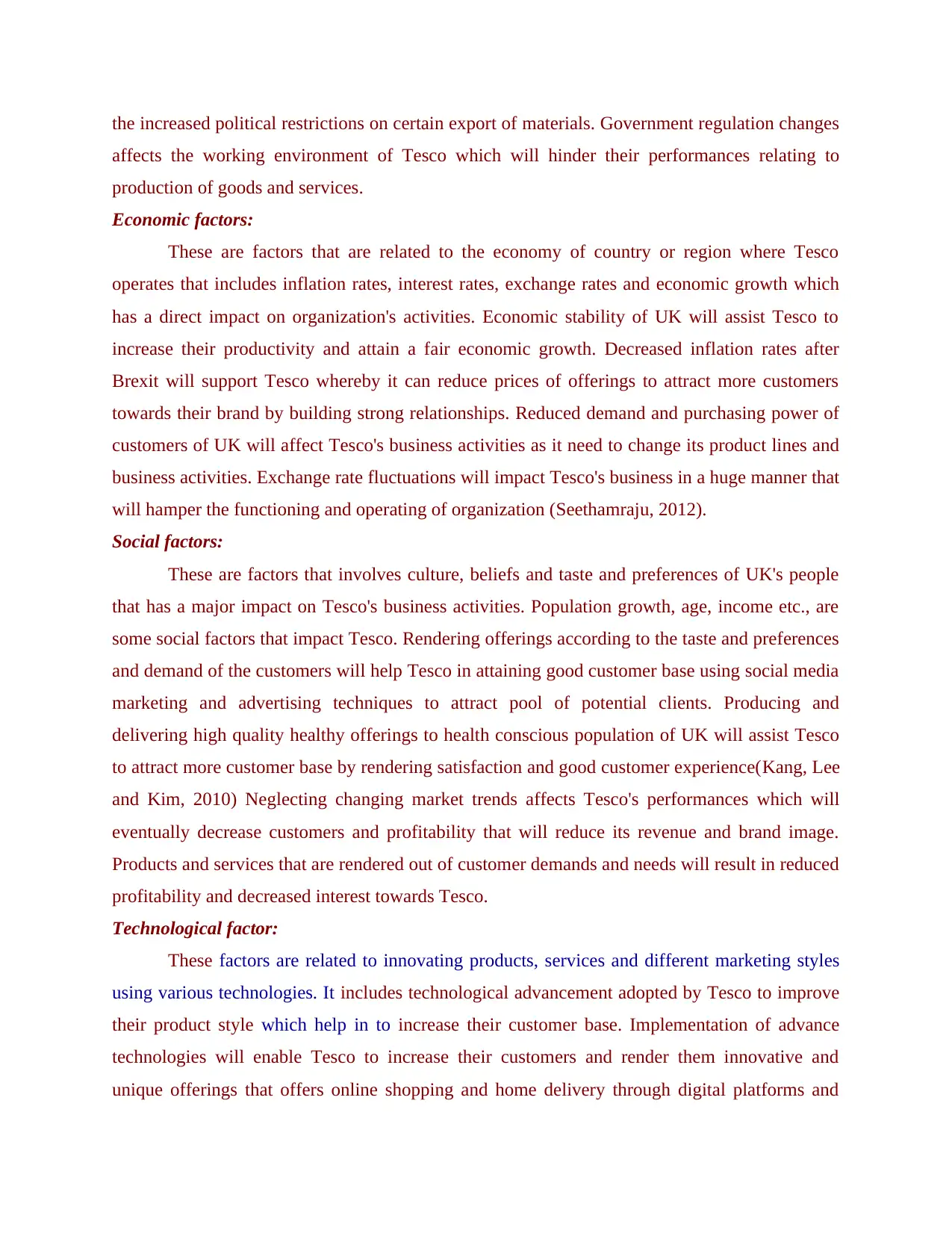
the increased political restrictions on certain export of materials. Government regulation changes
affects the working environment of Tesco which will hinder their performances relating to
production of goods and services.
Economic factors:
These are factors that are related to the economy of country or region where Tesco
operates that includes inflation rates, interest rates, exchange rates and economic growth which
has a direct impact on organization's activities. Economic stability of UK will assist Tesco to
increase their productivity and attain a fair economic growth. Decreased inflation rates after
Brexit will support Tesco whereby it can reduce prices of offerings to attract more customers
towards their brand by building strong relationships. Reduced demand and purchasing power of
customers of UK will affect Tesco's business activities as it need to change its product lines and
business activities. Exchange rate fluctuations will impact Tesco's business in a huge manner that
will hamper the functioning and operating of organization (Seethamraju, 2012).
Social factors:
These are factors that involves culture, beliefs and taste and preferences of UK's people
that has a major impact on Tesco's business activities. Population growth, age, income etc., are
some social factors that impact Tesco. Rendering offerings according to the taste and preferences
and demand of the customers will help Tesco in attaining good customer base using social media
marketing and advertising techniques to attract pool of potential clients. Producing and
delivering high quality healthy offerings to health conscious population of UK will assist Tesco
to attract more customer base by rendering satisfaction and good customer experience(Kang, Lee
and Kim, 2010) Neglecting changing market trends affects Tesco's performances which will
eventually decrease customers and profitability that will reduce its revenue and brand image.
Products and services that are rendered out of customer demands and needs will result in reduced
profitability and decreased interest towards Tesco.
Technological factor:
These factors are related to innovating products, services and different marketing styles
using various technologies. It includes technological advancement adopted by Tesco to improve
their product style which help in to increase their customer base. Implementation of advance
technologies will enable Tesco to increase their customers and render them innovative and
unique offerings that offers online shopping and home delivery through digital platforms and
affects the working environment of Tesco which will hinder their performances relating to
production of goods and services.
Economic factors:
These are factors that are related to the economy of country or region where Tesco
operates that includes inflation rates, interest rates, exchange rates and economic growth which
has a direct impact on organization's activities. Economic stability of UK will assist Tesco to
increase their productivity and attain a fair economic growth. Decreased inflation rates after
Brexit will support Tesco whereby it can reduce prices of offerings to attract more customers
towards their brand by building strong relationships. Reduced demand and purchasing power of
customers of UK will affect Tesco's business activities as it need to change its product lines and
business activities. Exchange rate fluctuations will impact Tesco's business in a huge manner that
will hamper the functioning and operating of organization (Seethamraju, 2012).
Social factors:
These are factors that involves culture, beliefs and taste and preferences of UK's people
that has a major impact on Tesco's business activities. Population growth, age, income etc., are
some social factors that impact Tesco. Rendering offerings according to the taste and preferences
and demand of the customers will help Tesco in attaining good customer base using social media
marketing and advertising techniques to attract pool of potential clients. Producing and
delivering high quality healthy offerings to health conscious population of UK will assist Tesco
to attract more customer base by rendering satisfaction and good customer experience(Kang, Lee
and Kim, 2010) Neglecting changing market trends affects Tesco's performances which will
eventually decrease customers and profitability that will reduce its revenue and brand image.
Products and services that are rendered out of customer demands and needs will result in reduced
profitability and decreased interest towards Tesco.
Technological factor:
These factors are related to innovating products, services and different marketing styles
using various technologies. It includes technological advancement adopted by Tesco to improve
their product style which help in to increase their customer base. Implementation of advance
technologies will enable Tesco to increase their customers and render them innovative and
unique offerings that offers online shopping and home delivery through digital platforms and
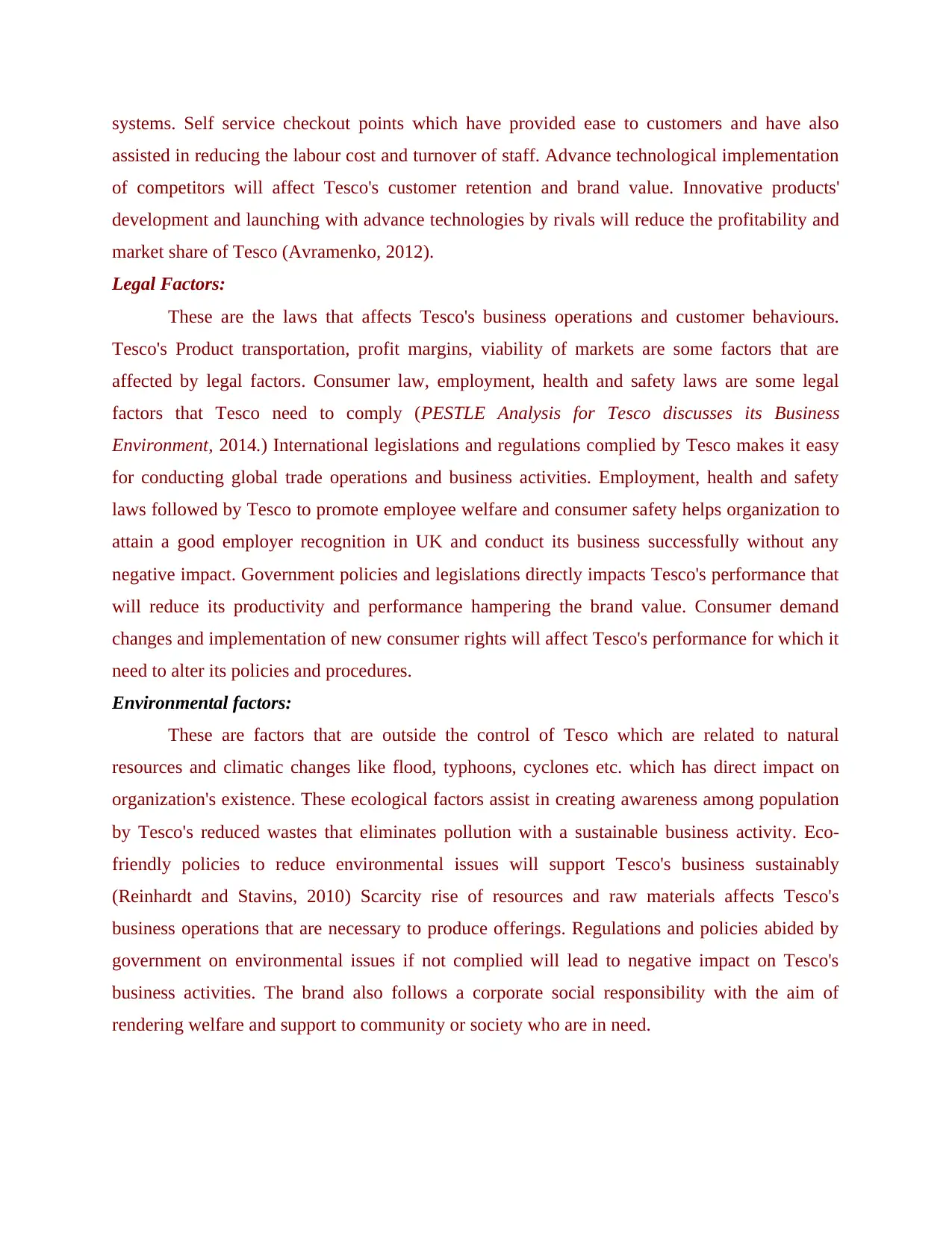
systems. Self service checkout points which have provided ease to customers and have also
assisted in reducing the labour cost and turnover of staff. Advance technological implementation
of competitors will affect Tesco's customer retention and brand value. Innovative products'
development and launching with advance technologies by rivals will reduce the profitability and
market share of Tesco (Avramenko, 2012).
Legal Factors:
These are the laws that affects Tesco's business operations and customer behaviours.
Tesco's Product transportation, profit margins, viability of markets are some factors that are
affected by legal factors. Consumer law, employment, health and safety laws are some legal
factors that Tesco need to comply (PESTLE Analysis for Tesco discusses its Business
Environment, 2014.) International legislations and regulations complied by Tesco makes it easy
for conducting global trade operations and business activities. Employment, health and safety
laws followed by Tesco to promote employee welfare and consumer safety helps organization to
attain a good employer recognition in UK and conduct its business successfully without any
negative impact. Government policies and legislations directly impacts Tesco's performance that
will reduce its productivity and performance hampering the brand value. Consumer demand
changes and implementation of new consumer rights will affect Tesco's performance for which it
need to alter its policies and procedures.
Environmental factors:
These are factors that are outside the control of Tesco which are related to natural
resources and climatic changes like flood, typhoons, cyclones etc. which has direct impact on
organization's existence. These ecological factors assist in creating awareness among population
by Tesco's reduced wastes that eliminates pollution with a sustainable business activity. Eco-
friendly policies to reduce environmental issues will support Tesco's business sustainably
(Reinhardt and Stavins, 2010) Scarcity rise of resources and raw materials affects Tesco's
business operations that are necessary to produce offerings. Regulations and policies abided by
government on environmental issues if not complied will lead to negative impact on Tesco's
business activities. The brand also follows a corporate social responsibility with the aim of
rendering welfare and support to community or society who are in need.
assisted in reducing the labour cost and turnover of staff. Advance technological implementation
of competitors will affect Tesco's customer retention and brand value. Innovative products'
development and launching with advance technologies by rivals will reduce the profitability and
market share of Tesco (Avramenko, 2012).
Legal Factors:
These are the laws that affects Tesco's business operations and customer behaviours.
Tesco's Product transportation, profit margins, viability of markets are some factors that are
affected by legal factors. Consumer law, employment, health and safety laws are some legal
factors that Tesco need to comply (PESTLE Analysis for Tesco discusses its Business
Environment, 2014.) International legislations and regulations complied by Tesco makes it easy
for conducting global trade operations and business activities. Employment, health and safety
laws followed by Tesco to promote employee welfare and consumer safety helps organization to
attain a good employer recognition in UK and conduct its business successfully without any
negative impact. Government policies and legislations directly impacts Tesco's performance that
will reduce its productivity and performance hampering the brand value. Consumer demand
changes and implementation of new consumer rights will affect Tesco's performance for which it
need to alter its policies and procedures.
Environmental factors:
These are factors that are outside the control of Tesco which are related to natural
resources and climatic changes like flood, typhoons, cyclones etc. which has direct impact on
organization's existence. These ecological factors assist in creating awareness among population
by Tesco's reduced wastes that eliminates pollution with a sustainable business activity. Eco-
friendly policies to reduce environmental issues will support Tesco's business sustainably
(Reinhardt and Stavins, 2010) Scarcity rise of resources and raw materials affects Tesco's
business operations that are necessary to produce offerings. Regulations and policies abided by
government on environmental issues if not complied will lead to negative impact on Tesco's
business activities. The brand also follows a corporate social responsibility with the aim of
rendering welfare and support to community or society who are in need.
⊘ This is a preview!⊘
Do you want full access?
Subscribe today to unlock all pages.

Trusted by 1+ million students worldwide
1 out of 17
Related Documents
Your All-in-One AI-Powered Toolkit for Academic Success.
+13062052269
info@desklib.com
Available 24*7 on WhatsApp / Email
![[object Object]](/_next/static/media/star-bottom.7253800d.svg)
Unlock your academic potential
Copyright © 2020–2025 A2Z Services. All Rights Reserved. Developed and managed by ZUCOL.





